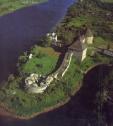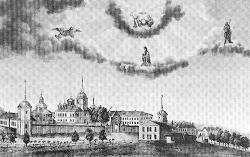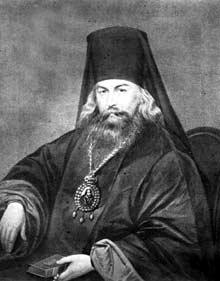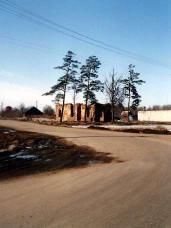Articles
/
Eparchy of Saint Petersburg
Eparchy of Saint Petersburg
Subject /
Religion. Church/Confession life
Eparchy of Saint Petersburg , territorial-administrative unit of ROC (Russian Orthodox Church). It was established according to the order of Empress Elizabeth Petrovna on 1 September 1742, before it was territorially included into the Novgorod Eparchy and the Synodal region. Nikodim (Srebnitsky), bishop of St Peresburg and Schlüsselburg, was the first ruling bishop in 1742-1745. In 1764 the Eparchy was classified as the 1st class eparchy, Estlandia and so named Russian Finland were included into it and Luga, Gdov, New Ladoga with their uyezds were included into the Eparchy in 1780-1781. From 1770 the capital archiereus has the title as the ruling bishop of St Petersburg and Revel, and from 1775 he was the first member of Synod with the title as the ruling bishop of Novgorod and St Petersburg (from 1783 he has the dignity of the metropolitan, the Novgorod Eparphy was ruled together with the Eparchy until 1892). The Eparchy became the centre of the clerical life of the country during the first metripolitan Gavriil (Petrov). The changing of gubernia borders in 1797 affected on eparchies and the St Petersbutg Gubernia, the Estlandia Gubernia, the Vyborg Gubernia, 23 cities and 324 churches were in these gubernia, were included in the Еparchy. In 1865 Estlandia was included into the Riga Eparchy and the title ""Finland"" was added to the title of the ruling archbishops, in 1892 Finland was arranged as the independent eparchy, simultaneously with the Novgorod Eparchy. From 1892 the borders of the Eparchy coincide with the borders of the St Petersburg Gubernia, and it was named as the Eparchy of St Petersburg (from 1914 as Petrograd) and Ladoga. Before 1917 the Eparchy of Saint Petersburg was governed by Archbishop Feodosy (Yankovsky; 1745-1750), Archbishop Silvestr (Kulyabka; 1750-1761); Archbishop Veniamin (Putsek-Grigorovich; 1761-1762), Archbishop Gavriil (Kremenetsky; 1762-1770), Metropolitan Gavriil (Petrov; 1770-1799), Metropolitan Amvrosy (Podobedov; 1799–1818), Metropolitan Mikhail (Desnitsky; 1818- 1821),Metropolitan Serafim (Glagolevsky; 1821-1843), Metropolitan Antony (Rafalsky; 1843-1848), Metropolitan Nikanor (Klementyevsky; 1848-1856),Metropolitan Grigory (Postnikov; 1856-1860), Metropolitan Isidor (Nikolsky; 1860-1892), Metropolitan Pallady (Rayev; 1892-1898), Metropolitan Antony (Vadkovsky; 1898–1912), Sainted Hierarch Vladimir (Bogoyavlensky; 1912-1915); Metropolitan Pitirim (Oknov; 1915-1917). The following suffragancies were in the Eparchy: the Revel suffragancy (1817-1865), the Vyborg suffragancy (1859-1892), the Ladoga suffragancy (1865-1892, 1917), the Narva suffragancy (1887–1917), the Gdov suffragancy (1892–1917), the Yamburg suffragancy (from 1897), the Kronstadt suffragancy (1907-1917). The Spiritual Consistory was under the direct rule of the metropolitan. The church administration and the church court were implemented using this Spiritual Consistory. There are ecclesiastical administrations in some cities in the first half of the 19th c. The deaneries were organized instead of ecclesiastical administrations after 1840. 10-30 parishes were included in each deanery. Four deaneries were organized at the Novaya Ladoga administration, three deaneries were organized at the St Petersburg administration, three deaneries were organized at the Gdov administration, three deaneries were organized at the Luga administration, three deaneries were organized at the Tsarskoye Selo administration, two deaneries were organized at the Yamburg administration to the end of the 19th c. There are also the Edinoverie deanery, the Estonia deanery and the monastery deanery. The Slavonic school was opened at the Monastery of St. Alexander Nevsky in 1721 (the General Seminary from 1788 , the St. Alexander Nevsky Academy from 1797, the St Petersburg Ecclesiastical Academy from 1809 ). Church parish schools and reading -writing schools worked under the Eparchy Brotherhood in the name of the Most Holy Mother of God. The St Petersburg Ecclesiastical -Censorship Committee, the Committee of the Orthodox Missionary Society, the Candle Factory, the Pension Cash and guardianships were the institutions of the Eparchy. Ten editions of the collection ""Historical Statistical Information on the Eparhy of St Petersburg "" were published in 1869-85. The magazine ""The St Petersburg Ecclesiastical Herald"" was published from 1895 , the magazine ""Information on the Eparchy of St Petersburg "" was published from 1902. 790 churches with 1700 priests and 16 monasteries with 1629 monks were in the Eparchy in 1917. The persecutions were begun after the October 1917 Revolution and the closing of monasteries, churches, seminaries was started. From the end of the 1920s the repressions were increased and in 1932-1933 the last monasteries, the Monastery of the Resurrection (the Remote Monastery of Macary) and the Monastery of the St Alexander Nevsky Lavra, were closed. 21 churches worked in the Eparchy in June of 1941 including eight churches in Leningrad. During WWII the Eparhy organized the patriotic work and donated Rb 1,7423,000 to the Defence Found. 117 churches were opened in the occupied territory under the patronage of the Pscov Ecclesiastical Mission. These churches belonged to the Baltic Exarchate of the Foreign Russian Orthodox Church (the most part of these churches were closed in 1944-1945). In 1946 the Ecclesiastical Academy and seminary were re-opened. There were 57 parishes in the Eparchy in 1949, including 16 parishes in Leningrad. 47 churches and 120 priests were remained in the Eparchy in 1965 after the new repressions during 1958-1964. During the Soviet period the Еparchy was governed by Metropolitan of Petrograd and Gdov St Veniamin (Kazansky; 1917-1922), Metropolitan of Leningrad Iosif (Petrovykh; 1926-1927), Metropolitan of Leningrad St. Serafim (Chichagov; 1928-1933), Metropolitan of Leningrad Aleksy (Simansky; 1933-1945), Metropolitan of Leningrad Grigory (Chukov; 1945-1955), Metropolitan of Leningrad Elevfery (Vorontsov; 1955-1959), Metropolitan of Leningrad Pitirim (Sviridov; 1959-1960), Metropolitan of Leningrad Gury (Egorov; 1960-1961), Metropolitan of Leningrad Pimen (Izvekov; 1961-1963), Metropolitan of Leningrad Nikodim (Rotov; 1963-1978), Metropolitan of Leningrad Antony (Melnikov; 1978-1986) . The revival of the Eparchy was begun under the governing of Metropolitan of Leningrad and Novgorod Alexis II (Ridiger; 1896-1890) in 1988, later he was Patriarch of Moscow and All Russia. The Eparchy was governed by Metropolitan of St Petersburg and Ladoga Ioann (Snychev) during 1990-1995. From 1995 the Eparchy is headed by Metropolitan of St Petersburg and Ladoga Vladimir (Kotlyarov). From 1990 the Eparchy borders coincide with borders of the Leningrad Oblast. There were 12 monasteries ( 9 monasteries were placed in the Leningrad Oblast), 442 parishes and the attached churches (224 parishes were in the Leningrad Oblast) in the Eparchy in 2005. Religious services are performed in 338 churches and 139 chapels by 509 priests and 139 deacons. From 1999 the Kazan Cathedral is the Cathedral Temple of the Eparchy of St Petersburg. 540 students learned in the Ecclesiastical Academy and the seminary in 2005, Archbishop of Tikhvin Konstantin (Goryanov) was the principal of the Ecclesiastical Academy. The parishes of the Eparhy consist of 20 deaneries subordinated to the St Petersburg Eparchy Administration which is headed by ruling archiereus. Under the ruling archiereus worked the Eparchy Council and seven departments - the publishing department, the missionary department, the religious education and catechisis department, the charity department, the department for the cooperation with the Armed Forces and low-enforcement organizations, the department for the fight with drugs and alcoholism, the department for the cooperation with GUIN (Main Prison Administration), the architecture and arts department - and also two commissions: caninization and audit. In 1998 the website of the Eparchy of St Petersburg was organized. From 2000 the Eparchy radio station ""City of Peter"" brodcasts every day. There are hospital of St Xenia the Blessed of St Petersburg, almshouse at the Church of St Andrew of Crete and others, children shelter ""House of Compassion"", Brotherhood of the Great Martyr Anastasia, hostels, charity canteens.
Authors
Shkarovsky, Mikhail Vitalyevich
Bertash, Aleksandr Vitalyevich
Persons
Alexis II (Ridiger Aleksey Mikhailovich), patriarch
Alexis (Sergey Vladimirivich Simansky), metropolitan
Amvrosy (Andrey Ivanovich Podobedov), metropolitan
Antony (Aleksandr Vasilyevich Vadkovsky), metropolitan
Antony (Melnikov), metropolitan
Antony (Rafalsky)
Elizabeth Petrovna, Empress
Feodosy (Yankovsky), archbishop
Gavriil (Kremenetsky), archbishop
Gavriil (Petrov), metropolitan
Grigory (Nikoilay Kirillovich Chukov), metropolitan
Grigory (Postnikov), metropolitan
Gury (Yegorov), metropolitan
Ioann (Ivan Matveyevich Snychev), metropilitan
Iosif (Petrovykh)
Isidor (Iakov Sergeyevich Nikolsky)
Konstantin (Oleg Aleksandrovich Goryanov), archbishop
Mikhail (Desnitsky), metropolitan
Nikanor (Klementyevsky), metropolitan
Nikodim (Boris Georgiyevich Rotov), metropolitan
Nikodim (Srebnitsky), bishop
Pallady (Pavel Ivanovich Rayev-Pisarev), metropolitan
Pimen (Izvekov), patriarch
Pitirim (Oknov), metropolitan
Pitirim (Sviridov), metropolitan
Serafim (Chichagov Leonid Mikhailovich), metropolitan
Serafim (Stefan Vasilyevich Glagolevsky), metropolitan
Silvester (Semyon Petrovich Kulyabka), archbishop
Veniamin (Kazansky), metropolitan
Veniamin (Putsek-Grigorovich)
Vladimir (Bogoyavlensky), metropolitan
Vladimir (Vladimir Savvich Kotlyarov), metropolitan
Yelevfery (Vorontsov), metropolitan
Geography
Neighbouring Territories/Pskov Oblast, the/Gdov Town
Leningrad Oblast, the/Luga District/Luga Town
Leningrad Oblast, the/Volkhov District/Novaya Ladoga Town
Historical Toponyms/Vyborg Gubernia
Bibliography
Очерки истории Санкт-Петербургской епархии. СПб., 1994
Шкаровский М. В. Петербургская епархия в годы гонений и утрат, 1917–1945. СПб., 1995
Справочник по С.-Петерб. епархии. СПб., 2001.
Земля Невская Православная: Краткий церковно-исторический справочник / Науч. ред. В.В. Антонов. СПб., 2006.
Санкт-Петербургская митрополия. Официальный сайт. URL: http://mitropolia-spb.ru
Mentioned in articles:
|
hidden
|
Eparhy of Novgorod
Eparhy of Novgorod. It is one of the oldest eparchies in Russia (it has been being since 992). The eparchy was the largest, it included five administrative regions (pyatinas) as well as the Pskov, Onega Lake, Karelia lands and the region of the... more
|
|
|
|
hidden
|
Holy Trinity Monastery of St. Antony Dymsky, the
The Holy Trinity Monastery of St. Anthony Dymsky (the settlement of Bronevik, the Boksitogorsk district) is one of the ancientest in the Saint Petersburg eparchy. It was founded by Venerable Anthony Dymsky (according to a version of the... more
|
|
|
|
hidden
|
Ignaty (Bryanchaninov) (1807-1867), sainted hierach, clergy figure
Ignaty (Dmitry Aleksandrovich Bryanchaninov; 1807-1867), an ecclesiastical writer, theologian, sainted hierach. Dmitry Aleksandrovich Bryanchaninov studied in the Main Engineering College in St. Petersburg from 1822 untill 1827. He was in the first... more
|
|
|
|
hidden
|
Russian-Estonian deanary
Russian-Estonian deanary. People of the Baltic States were originally baptized by the Orthodox Church, from 13th с they were converted in Catholicism, from 16th с they were converted in Lutheran. In 1841 the Estonia peasants began to convert... more
|
|
|
|
hidden
|
Staraya Ladoga Dormition Convent, the
The Staraya Ladoga Dormition Convent (the Volkhov district, the village of Staraya Ladoga) is one the most ancient monasteries in the St. Petersburg Eparchy. It was presumably founded in the first quarter of the 12th century as a prince's convent... more
|
|
|
|










